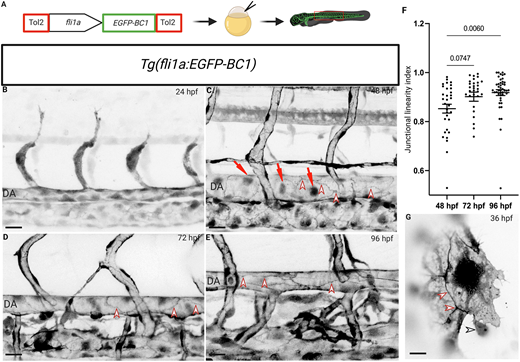Fig. 1 The endothelial-specific β-catenin chromobody exhibits expression in endothelial nuclei and cell-cell junctions and can be used to monitor junctional maturation during zebrafish development. (A) Schematic of the fli1a:EGFP-BC1 construct. (B-E) Trunk vasculature of Tg(fli1a:EGFP-BC1) zebrafish from 24 to 96 hpf. Chromobody expression localizes to endothelial nuclei (red arrows) and at cell membranes (red arrowheads). (F) Junctional linearity index at 48 (n=32 junctions from six embryos), 72 (n=30 junctions from six larvae) and 96 (n=44 junctions from seven larvae) hpf. Data are mean±s.d.; P-value calculated using an unpaired two-tailed Student's t-test. (G) Single plane spinning disc confocal image of a single endothelial cell during CCV formation at 36 hpf. The β-catenin chromobody exhibits a dynamic localization (see Movie 1), especially at endothelial cell-cell junctions; interactions of red blood cells with endothelial cells can also be observed (red arrowheads point to endothelial cell-cell junctions; black arrowhead points to a red blood cell interacting with an endothelial cell). Scale bars: 40 μm (B-E); 10 μm (G).
Image
Figure Caption
Acknowledgments
This image is the copyrighted work of the attributed author or publisher, and
ZFIN has permission only to display this image to its users.
Additional permissions should be obtained from the applicable author or publisher of the image.
Full text @ Development

